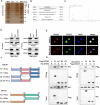CDCA7 enhances STAT3 transcriptional activity to regulate aerobic glycolysis and promote pancreatic cancer progression and gemcitabine resistance
- PMID: 39905019
- PMCID: PMC11794584
- DOI: 10.1038/s41419-025-07399-1
CDCA7 enhances STAT3 transcriptional activity to regulate aerobic glycolysis and promote pancreatic cancer progression and gemcitabine resistance
Abstract
Cell division cycle associated 7 (CDCA7) plays a role in various malignancies, especially pancreatic cancer (PC). However, its expression pattern and functional significance in PC require further research. Therefore, this study aimed to investigate CDCA7 expression levels and biological functions in PC using in vitro and in vivo experiments. Western blotting, immunohistochemistry, and real-time polymerase chain reaction were performed to detect CDCA7 expression in PC cells and tissues. Additionally, the biological functions of CDCA7 were assessed using cell proliferation, wound healing, and Transwell assays. CDCA7 overexpression promoted PC cell proliferation, migration, and invasion, and increased resistance to the chemotherapy drug gemcitabine, possibly through enhanced aerobic glycolysis. Additionally, immunoprecipitation assay showed that CDCA7 interacted with STAT3 protein and affected the transcriptional regulation of hexokinase 2. Conclusively, targeting CDCA7 might be a promising therapeutic strategy to increase gemcitabine sensitivity by inhibiting glycolysis in PC cells.
© 2025. The Author(s).
Conflict of interest statement
Competing interests: The authors declare no competing interests. Ethics approval and consent to participate: All procedures followed were in accordance with the ethical standards of the Ethical Committee of the Affiliated Hospital of Guizhou Medical University. All institutional and national guidelines for the care and use of laboratory animals were followed. Consent to publication: All authors have agreed to publish this manuscript.
Figures







References
-
- Siegel RL, Giaquinto AN, Jemal A. Cancer statistics, 2024. CA Cancer J Clin. 2024;74:12–49. - PubMed
-
- Rahib L, Smith BD, Aizenberg R, Rosenzweig AB, Fleshman JM, Matrisian LM. Projecting cancer incidence and deaths to 2030: the unexpected burden of thyroid, liver, and pancreas cancers in the United States. Cancer Res. 2014;74:2913–2921. - PubMed
-
- Conroy T, Pfeiffer P, Vilgrain V, Lamarca A, Seufferlein T, O’Reilly EM, et al. Pancreatic cancer: ESMO Clinical Practice Guideline for diagnosis, treatment and follow-up. Ann Oncol. 2023;34:987–1002. - PubMed
MeSH terms
Substances
Grants and funding
LinkOut - more resources
Full Text Sources
Medical
Miscellaneous

